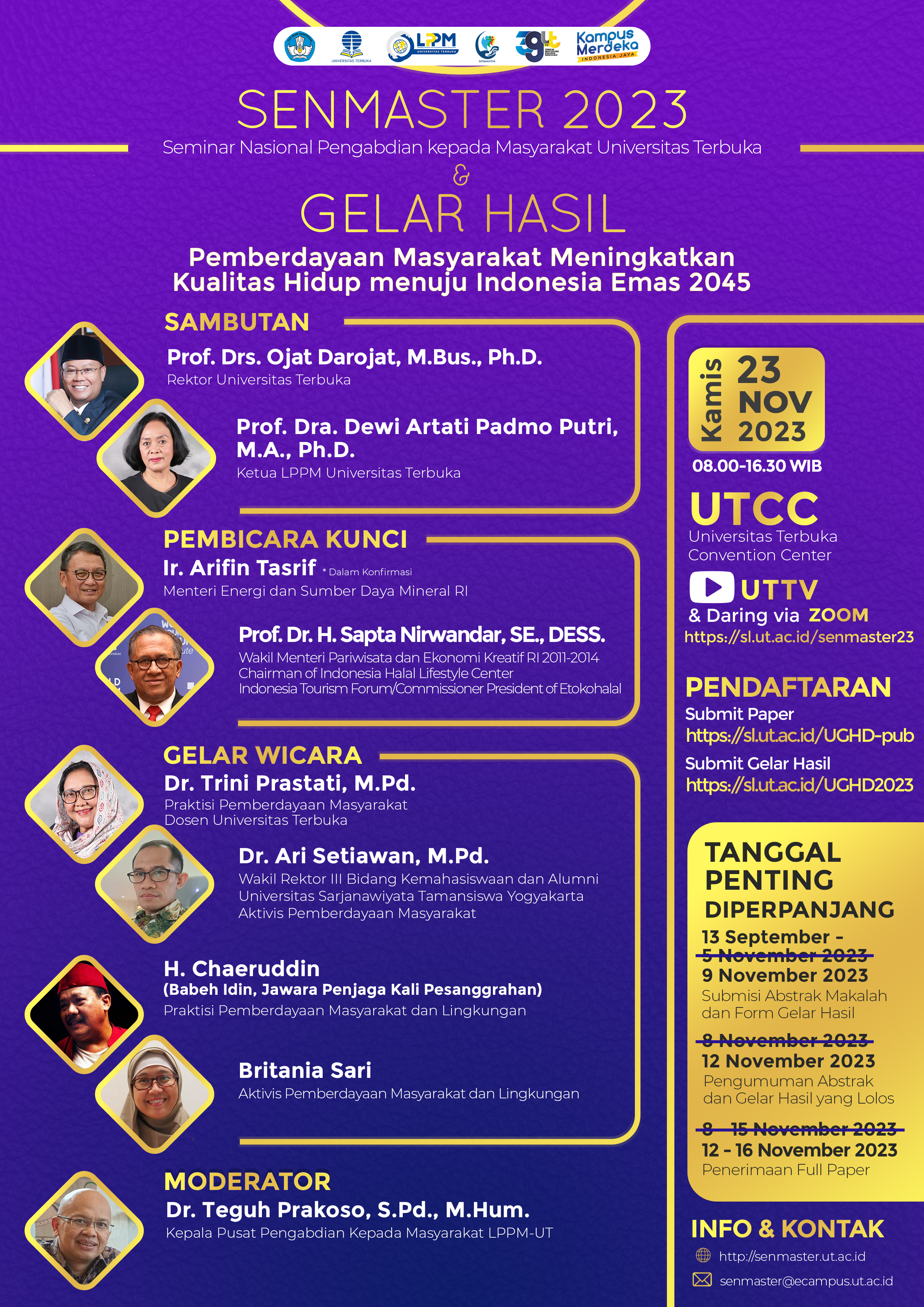Abstract
This paper explores strategies for alleviating poverty in the Special Region of Yogyakarta by strengthening the tourism, agricultural, and marine sectors to achieve sustainable development goals in the era of Society 5.0. The study uses qualitative research methods as well as empirical research methods with descriptive analysis techniques. The analysis highlights the potential of the tourism sector as a driver of economic growth, job creation, and community development. It emphasizes the importance of infrastructure development, community-based tourism, and technological integration in harnessing the sector's potential. Furthermore, the agricultural sector offers opportunities for enhanced productivity, market access, and sustainable farming practices. Strategies such as agricultural innovation, market development, and sustainable farming techniques can contribute to poverty reduction and economic empowerment. The marine sector, with its fisheries and coastal resources, presents avenues for income generation and environmental conservation. Recommendations encompass sustainable fisheries management, aquaculture development, and coastal and marine tourism initiatives. Additionally, the paper addresses the significance of multi-stakeholder collaboration, capacity building, and monitoring systems for effective implementation and evaluation. The inclusion of these elements can drive inclusive and sustainable development outcomes. By adopting these strategies and policy recommendations, Yogyakarta can leverage its strengths and resources to alleviate poverty, achieve sustainable development goals, and contribute to the vision of Society 5.0.
References
Banerjee, A., & Duflo, E. (2007). The Economic Lives of the Poor. Journal of Economic Perspectives, 21(1), 141-167.
Ravallion, M. (2012). Troubling Tradeoffs in the Human Development Index. Journal of Development Economics, 99(2), 201-209.
Acemoglu, D., Johnson, S., & Robinson, J. A. (2001). The Colonial Origins of Comparative Development: An Empirical Investigation. American Economic Review, 91(5), 1369-1401.
Easterly, W., & Levine, R. (1997). Africa's Growth Tragedy: Policies and Ethnic Divisions. Quarterly Journal of Economics, 112(4), 1203-1250.
Besley, T., & Burgess, R. (2003). Halving Global Poverty. Journal of Economic Perspectives, 17(3), 3-22.
Banerjee, A., & Duflo, E. (2011). Poor Economics: A Radical Rethinking of the Way to Fight Global Poverty. Public Affairs.
Morduch, J. (1999). The Microfinance Promise. Journal of Economic Literature, 37(4), 1569-1614.
Sachs, J. D. (2005). The End of Poverty: Economic Possibilities for Our Time. Penguin Books.
Foster, J., Greer, J., & Thorbecke, E. (1984). A Class of Decomposable Poverty Measures. Econometrica, 52(3), 761-766.
Deaton, A. (2010). Instruments, Randomization, and Learning about Development. Journal of Economic Literature, 48(2), 424-455.
Sen, A. (1981). Poverty and Famines: An Essay on Entitlement and Deprivation. Oxford University Press.
World Bank. (2000). World Development Report 2000/2001: Attacking Poverty. World Bank Publications.
Jolliffe, D. (2004). The World Bank's Role in Poverty Reduction: A Review of Its Approaches and Instruments. Journal of Development Studies, 40(6), 1-30.
Todaro, M. P., & Smith, S. C. (2015). Economic Development (12th ed.). Pearson.
Barro, R. J., & Sala-i-Martin, X. (2004). Economic Growth (2nd ed.). MIT Press.
Foster, J., & Székely, M. (2008). Is Economic Growth Good for the Poor? Tracking Low Incomes Using General Means. Journal of Development Economics, 86(2), 312-326.
Karlan, D., & Zinman, J. (2010). Expanding Microenterprise Credit Access: Using Randomized Supply Decisions to Estimate the Impacts in Manila. Review of Economics and Statistics, 92(4), 985-1008.
Duflo, E., Kremer, M., & Robinson, J. (2011). Nudging Farmers to Use Fertilizer: Theory and Experimental Evidence from Kenya. American Economic Review, 101(6), 2350-2390.
Muralidharan, K., & Sundararaman, V. (2011). Teacher Performance Pay: Experimental Evidence from India. Journal of Political Economy, 119(1), 39-77.
Besley, T., & Kanbur, R. (1993). Food Subsidies and Poverty Alleviation. Economic Journal, 103(416), 1-16.
Coady, D., Grosh, M., & Hoddinott, J. (2004). Targeting of Transfers in Developing Countries: Review of Experience and Lessons. World Bank Publications.
Dasgupta, P. (1993). An Inquiry into Well-Being and Destitution. Oxford University Press.
Kabeer, N. (2005). Gender Equality and Women's Empowerment: A Critical Analysis of the Third Millennium Development Goal. Gender & Development, 13(1), 13-24.
Banerjee, A., et al. (2015). The Miracle of Microfinance? Evidence from a Randomized Evaluation. American Economic Journal: Applied Economics, 7(1), 22-53.
Barrett, C. B., et al. (2001). Decentralization and Community-Based Resource Management: Theory
Das, J., et al. (2012). The Impact of Training Informal Health Care Providers in India: A Randomized Controlled Trial. Science, 338(6104), 612-616.
Fafchamps, M., & Minten, B. (2001). Returns to Social Network Capital Among Traders. Oxford Economic Papers, 53(4), 605-628.
Field, E., et al. (2010). The Returns to Microenterprise Support Among the Ultrapoor: A Field Experiment in Postwar Uganda. American Economic Journal: Applied Economics, 2(2), 35-64.
Karlan, D., & Valdivia, M. (2011). Teaching Entrepreneurship: Impact of Business Training on Microfinance Clients and Institutions. Review of Economics and Statistics, 93(2), 510-527.
Kremer, M., & Miguel, E. (2007). The Illusion of Sustainability. The Quarterly Journal of Economics, 122(3), 1007-1065.
McKenzie, D., & Woodruff, C. (2014). Business Practices in Small Firms in Developing Countries. Management Science, 60(3), 738-753.
Rosenzweig, M. R., & Binswanger, H. P. (1993). Wealth, Weather Risk and the Composition and Profitability of Agricultural Investments. The Economic Journal, 103(416), 56-78.
Udry, C. (1996). Gender, Agricultural Production, and the Theory of the Household. Journal of Political Economy, 104(5), 1010-1046.

